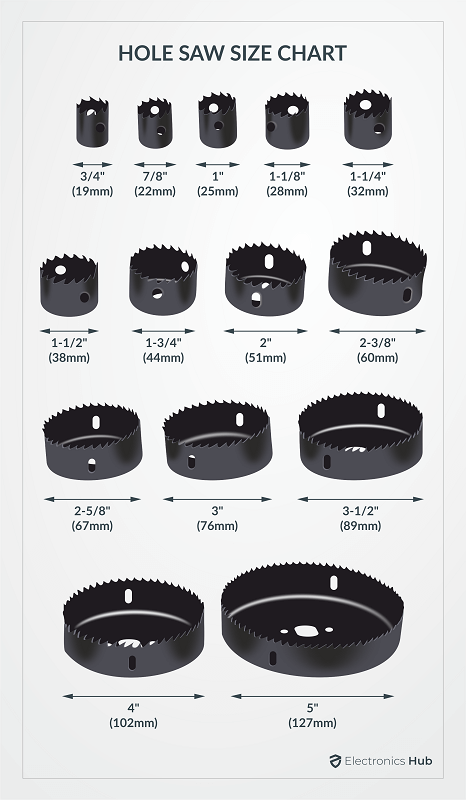A Brief Note on Hole Saw
When ever we need to make holes in any object, we use a regular drill with appropriate drill bit size. For slightly larger holes, there are special bits known as Spade Bits. You can use spade bits to make bigger holes, say up to 1” diameter at most. But what if you need to make even larger holes? This is where Hole Saws come handy. Imagine a Band Saw Blade wrapped in a circle. This is a close description to what a Hole Saw looks like. Most Hole Saws fix to an arbor or mandrel that contains a collar, drive pins, a pilot bit and a shaft. Using the drive pins, we have to first secure the hole saw to the arbor. Then slide the arbor shaft into a drill and you can start using the hole saw. The pilot bit of the arbor allows you to make a pilot hole at the center of the piece that you want to remove. Hole Saws can drill holes in sheets of drywall, steel, aluminum, wood and many other materials.
Types of Hole Saws
There are several types of hole saws and the main differentiation is the type of material they are made up of. But we can use the type of tips/blades they use to classify them. Here are some popular types of hole saws:
Bimetal Hole Saw Tungsten Carbide Tipped Hole Saw Carbon Steel Hole Saw Cobalt Hole Saw Diamond Edged Hole Saw Smooth Cut Hole Saw Gulleted Hole Saw Welded Shank Hole Saw Circular Tile Hole Saw Hole Cutter
Let us now briefly see about some of the above-mentioned hole saws.
Bimetal Hole Saw
As the name suggests, a bimetal hole saw is made from a bi-metal material. The bodies are usually made from carbon steel while the teeth are made from high-speed steel. They are one of the most popular types of holes for making holes in brass, bronze, aluminum, cast iron, plastic, wood (hardwood, plywood, etc.).
Carbon Steel Hole Saw
They are slightly less durable than bimetal counterparts but even they are general purpose hole saws suitable for home jobs, DIYer and small workshops. Due to the nature of the material, we have to carbon steel hole saws only on light-weight applications. Some materials on which you can use carbon steel hole saws are: drywall, plywood, plastic etc.
Tungsten Carbide Hole Saws
In this type of hole saws, the teeth are usually treated with carbide coating for additional strength. The result is fast cutting action as well as very long life. The regular teeth type carbide hole saws are suitable for non-ferrous metals as well as hardwood, plastic etc. But the gulleted square teeth one is even tough an you can use it on bricks, concrete, marble etc.
Hole Saw Size Chart
Like other popular tools, even hole saws are available in a multitude of sizes. Some material types start at a diameter of 5/8” and go all the way to 6”. We will now take a look at the Hole Saw Size Chart for some popular types. Note that the best way to get accurate values on the sizes of hole saws is to refer to the manufacturer’s hole saw size charts. They provide with all the necessary details including the part number.
Bi-Metal Hole Saw Size Chart
Carbide Tipped Hole Saw Size Chart
Conclusion
Hole Saw is a very interesting tool. You can easily make holes with diameters of 6” or more using hole saws in wood, metal, plastic, gypsum etc. They are available in different material types as well as plethora of sizes. In this guide, we saw about Hole Saws, different types of Hole Saws and also souple of important hole saw size chart. Comment * Name * Email * Website
Δ






![]()